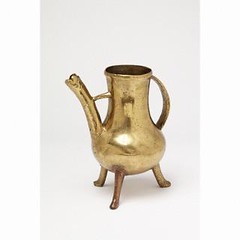By Stuart Frost
Over the last few years I’ve become increasingly familiar with the V&A’s fantastic medieval and Renaissance collections. Those of us fortunate enough to be developing the new galleries all have our favourite objects. The 19th century photographic copy of the Bayeux Tapestry is certainly one of mine, even though it isn’t a real medieval artefact.
 At the moment I’m particularly enamoured with a wonderful brass jug with three feet. Click on the picture to the right for a better view. The jug is destined for a new home in 2009, when it will become part of a display exploring dining between 1350-1500. I’ve been trying to think why I like this jug so much. It isn’t a world famous treasure, it wasn’t made by a well-known artist, nor was it owned by a famous patron. It isn’t made of a precious materials and its decoration is plain. It does, however, have undeniable personality and charm. When I first saw it I thought it looked as though it might come to life at any moment, scamper down of its shelf and start running around on its three stumpy legs. At first I thought this might be a sign that I needed a holiday. Then I realised that subconsciously I’d made a connection between the jug and a sequence in Walt Disney’s Fantasia where Mickey Mouse, dressed as a wizard, casts a spell that results in mops and buckets running amock.
At the moment I’m particularly enamoured with a wonderful brass jug with three feet. Click on the picture to the right for a better view. The jug is destined for a new home in 2009, when it will become part of a display exploring dining between 1350-1500. I’ve been trying to think why I like this jug so much. It isn’t a world famous treasure, it wasn’t made by a well-known artist, nor was it owned by a famous patron. It isn’t made of a precious materials and its decoration is plain. It does, however, have undeniable personality and charm. When I first saw it I thought it looked as though it might come to life at any moment, scamper down of its shelf and start running around on its three stumpy legs. At first I thought this might be a sign that I needed a holiday. Then I realised that subconsciously I’d made a connection between the jug and a sequence in Walt Disney’s Fantasia where Mickey Mouse, dressed as a wizard, casts a spell that results in mops and buckets running amock.
In fact this type of connection isn’t as implausible or ridiculous as it might sound at first. ‘Once Upon a Time, Walt Disney’ at the Grand Palais (16 September 2006 to 15 January 2007) is an exhibition that highlights the sources of inspiration for some of Disney’s greatest animations. Many of the ideas were developed from medieval or Renaissance sources. The castle in Sleeping Beauty takes some elements from the castles of Louis II of Bavaria and others from the lavish illuminations of a famous book of hours (Les Très Riches Heures du Duc de Berry). The wicked Queen in Snow White was based partly on a Gothic sculpture of Queen Uta that can be seen in Naumberg Cathedral, Germany. Pinocchio’s hometown was inspired by the medieval town of Rothenburg in Bavaria. Identifying these sort of obscure links and reference points is strangely satisfying.
Most of the films mentioned above were made before 1940 but medieval and Renaissance culture continues to provide inspiration for the film industry and theatre. The costumes and set designs in the Lord of the Rings trilogy were inspired by the culture of the medieval and Renaissance world. The city of Gondar was inspired by Sienna for example, and I’m sure there must be many other examples in recent films and cartoons. Our initial audience research indicated that films like Robin Hood and the Lord of the Rings were important reference points for many of our visitors, helping shape their perceptions of the medieval period in particular.
As part of the plans to redisplay the collections we did consider developing a series of short animations to run on small screens in the galleries alongside the relevant objects but in the end we decided to develop other ideas instead. Still, given the links with the Middle Ages maybe we’ll be able to show Snow White as part of a film festival to accompany the opening of the galleries?
If you’ve yet to find your own favourite medieval or Renaissance object at the V&A highlights are displayed currently in Rooms 46 and 17-20.
You can also Search the Collections online
Click here to find out more about Once Upon a Time, Walt Disney: The Disney Studios’ Artistic Sources
Comments